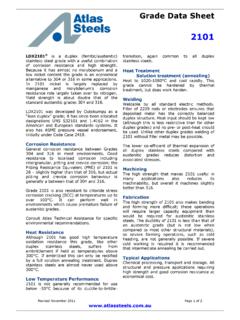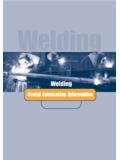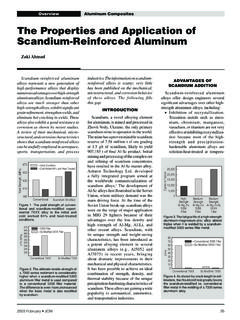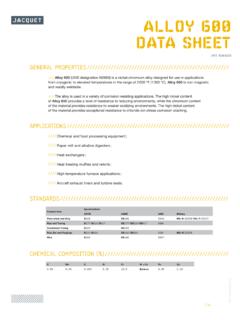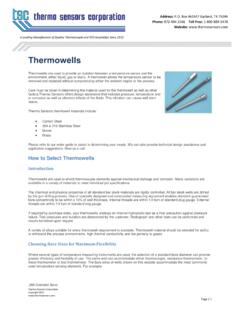Transcription of STAINLESS STEELS - APPLICATIONS, GRADES AND …
1 Updated 8/2/20021 STAINLESS STEELS - applications , GRADES AND human exposure tony newson avestapolarit Oyj Abp October 2001 New edition, February 2002 Updated 8/2/20022 STAINLESS STEELS applications , GRADES and human ExposureIntroductionThe following information has been prepared by tony newson (Avesta Polarit, UK), on behalf of the Eurofer STAINLESS steel Producers Group. It is provided at the request of the Danish EPA to assist their work on the Risk Assessment of metallic nickel, nickel sulphate, nickel chloride, nickel dinitrate and nickel information is presented in broad categories of use (eg transport, consumer goods, etc), which each provide details of applications , the STAINLESS steel GRADES used for those applications and an assessment of human exposure encountered in each specific application. Each individual broad category is introduced by general background information designed to provide an overview of the use of STAINLESS STEELS in that particular STAINLESS steel FamilyStainless steel is the term used to describe an extremely versatile family of engineering materials, which are selected primarily for their corrosion and heat resistant STAINLESS STEELS contain principally iron and a minimum of chromium.
2 At this level, chromium reacts with oxygen and moisture in the environment to form a protective, adherent and coherent, oxide film that envelops the entire surface of the material. This oxide film (known as the passive or boundary layer) is very thin (2-3 namometres). [1nanometre = 10-9m].The passive layer on STAINLESS STEELS exhibits a truly remarkable property: when damaged ( abraded), it self-repairs as chromium in the steel reacts rapidly with oxygen and moisture in the environment to reform the oxide the chromium content beyond the minimum of confers still greater corrosion resistance. Corrosion resistance may be further improved, and a wide range of properties provided, by the addition of 8% or more nickel. The addition of molybdenum further increases corrosion resistance (in particular, resistance to pitting corrosion), while nitrogen increases mechanical strength and enhances resistance to of STAINLESS SteelsThe STAINLESS steel family tree has several branches, which may be differentiated in a variety of ways in terms of their areas of application, by the alloying elements used in their production, or, perhaps the most accurate way, by the metallurgical phases present in their microscopic structures:-Ferritic-Martensitic (including precipitation hardening STEELS )-Austenitic-Duplex STEELS , consisting of mixture of ferrite and austeniteWithin each of these groups, there are several GRADES of STAINLESS steel defined according to their compositional ranges.
3 These compositional ranges are defined in European (and other USA) standards, and within the specified range, the STAINLESS steel grade will exhibit all of the desired properties ( corrosion resistance and/or heat resistance and/or machineability). More detail on standards and GRADES is given STAINLESS STEELS ( GRADES and ) consist of chromium (typically or 17%) and iron. Ferritic STAINLESS STEELS are essentially nickel-free. These materials contain very little carbon and are non-heat treatable, but exhibit superior corrosion resistance to martensitic STAINLESS STEELS and possess good resistance to oxidation. They are ferromagnetic and, although subject to an impact transition ( become brittle) at low temperatures, possess adequate formability. Their thermal expansion and other thermal properties are similar to conventional STEELS . Ferritic STAINLESS STEELS are readily welded in thin sections, but suffer grain growth with consequential loss of properties when welded in thicker 8/2/20023 Martensitic STAINLESS STEELS ( GRADES , and ) consist of carbon ( ), chromium ( ) and iron.
4 These materials may be heat treated, in a similar manner to conventional STEELS , to provide a range of mechanical properties, but offer higher hardenability and have different heat treatment temperatures. Their corrosion resistance may be described as moderate ( their corrosion performance is poorer than other STAINLESS STEELS of the same chromium and alloy content). They are ferromagnetic, subject to an impact transition at low temperatures and possess poor formability. Their thermal expansion and other thermal properties are similar to conventional STEELS . They may be welded with caution, but cracking can be a feature when matching filler metals are STAINLESS STEELS ( GRADES and ) consist of chromium (16-26%), nickel (6-12%) and iron. Other alloying elements ( molybdenum) may be added or modified according to the desired properties to produce derivative GRADES that are defined in the standards ( ).
5 The austenitic group contains more GRADES , that are used in greater quantities, than any other category of STAINLESS steel . Austenitic STAINLESS STEELS exhibit superior corrosion resistance to both ferritic and martensitic STAINLESS STEELS . Corrosion performance may be varied to suit a wide range of service environments by careful alloy adjustment by varying the carbon or molybdenum content. These materials cannot be hardened by heat treatment and are strengthened by work-hardening. Unlike ferritic and martensitic STAINLESS STEELS , austenitic GRADES do not exhibit a yield point. They offer excellent formability and their response to deformation can be controlled by chemical composition. They are not subject to an impact transition at low temperatures and possess high toughness to cryogenic temperatures. They exhibit greater thermal expansion and heat capacity, with lower thermal conductivity than other STAINLESS or conventional STEELS .
6 They are generally readily welded, but care is required in the selection of consumables and practices for more highly alloyed GRADES . Austenitic STAINLESS STEELS are often described as non-magnetic, but may become slightly magnetic when machined or STAINLESS STEELS ( grade S31803) consist of chromium (18-26%) nickel (4-7%), molybdenum (0-4%), copper and iron. These STAINLESS STEELS have a microstructure consisting of austenite and ferrite, which provides a combination of the corrosion resistance of austenitic STAINLESS STEELS with greater strength. Duplex STAINLESS STEELS are weldable, but care must be exercised to maintain the correct balance of austenite and ferrite. They are ferromagnetic and subject to an impact transition at low temperatures. Their thermal expansion lies between that of austenitic and ferritic STAINLESS STEELS , while other thermal properties are similar to plain carbon STEELS . Formability is reasonable, but higher forces than those used for austenitic STAINLESS STEELS are of Alloying on Structure and PropertiesChromiumChromium is by far the most important alloying element in STAINLESS steel production.
7 A minimum of chromium is required for the formation of a protective layer of chromium oxide on the steel surface. The strength of this protective (passive) layer increases with increasing chromium content. Chromium prompts the formation of ferrite within the alloy structure and is described as ferrite improves general corrosion resistance and prompts the formation of austenite ( it is an austenite stabiliser). STAINLESS STEELS with 8-9% nickel have a fully austenitic structure and exhibit superior welding and working characteristics to ferritic STAINLESS STEELS . Increasing nickel content beyond 8-9% further improves both corrosion resistance (especially in acid environments) and (and tungsten)Molybdenum increases resistance to both local (pitting, crevice corrosion, etc) and general corrosion. Molybdenum and tungsten are ferrite stabilisers which, when used in austenitic alloys, must be balanced with austenite stabilisers in order to maintain the austenitic structure.
8 Molybdenum is added to martensitic STAINLESS STEELS to improve high temperature increases strength and enhances resistance to localised corrosion. It is austenite 8/2/20024 CopperCopper increases general corrosion resistance to acids and reduces the rate of work-hardening ( it is used in cold-headed products such as nails and screws). It is an austenite enhances strength (especially, in hardenable martensitic STAINLESS STEELS ), but may have an adverse affect on corrosion resistance by the formation of chromium carbides. It is an austenite (and niobium & zirconium)Where it is not desirable or, indeed, not possible to control carbon at a low level, titanium or niobium may be used to stabilise STAINLESS steel against intergranular corrosion. As titanium (niobium and zirconium) have greater affinity for carbon than chromium, titanium (niobium and zirconium) carbides are formed in preference to chromium carbide and thus localised depletion of chromium is prevented.
9 These elements are ferrite is added to improve the machinability of STAINLESS STEELS . As a consequence, sulphur-bearing STAINLESS STEELS exhibit reduced corrosion resistance. CeriumCerium, a rare earth metal, improves the strength and adhesion of the oxide film at high is an austenite former, which increases the solubility of nitrogen in the steel and may be used to replace nickel in nitrogen-bearing improves resistance to oxidation and is also used in special STAINLESS STEELS exposed to highly concentrated sulphuric and nitric acids. Silicon is a ferrite steel grade DesignationsWith the exception of the tables of applications for medical devices, STAINLESS STEELS are primarily described by designations given in EN 10088 STAINLESS STEELS (for general purposes). These designations follow the Werkstoff numbering system for STEELS originally developed in German ( ). The Werkstoff numbering system has also been used as the basis for other European Standards for STEELS ( high temperature STAINLESS STEELS ).
10 For simplicity, these additional standards have not been referenced in this text. However, their Werkstoff grade designations have been used to describe high temperature STAINLESS STEELS and they are may be identified by the designation ( ) to indicate high temperature applications . Common US designations are also given ( AISI 303, ASTM S41050) to further aid recognition of the STAINLESS steel alloys named for particular (non-implant) devices are also described in terms of both EN 10088 and US designations, but in addition reference is made to specific standards applicable to medical devices ( ISO 7153-1). Medical implants have specific material specifications ( ISO 5832-1 and ISO 5832-9), which do not have an equivalent EN 10088 8/2/20025 applications - TransportAerospaceMaterials for aerospace applications are required to maintain the integrity of the structure ( to be sufficiently robust to withstand their service environment) and to be inert (ie corrosion resistant).

